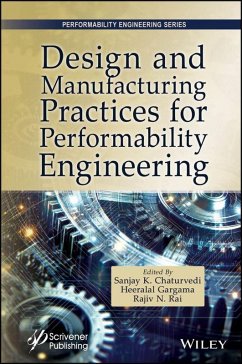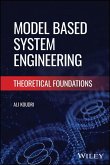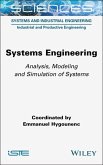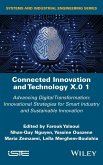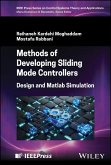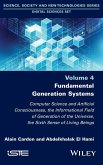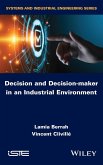Design and Manufacturing Practices for Performability Engineering
Herausgeber: Chaturvedi, Sanjay Kumar; Rai, Rajiv Nandan; Gargama, Heeralal
Design and Manufacturing Practices for Performability Engineering
Herausgeber: Chaturvedi, Sanjay Kumar; Rai, Rajiv Nandan; Gargama, Heeralal
- Gebundenes Buch
- Merkliste
- Auf die Merkliste
- Bewerten Bewerten
- Teilen
- Produkt teilen
- Produkterinnerung
- Produkterinnerung
"As technology continues to reshape the world, this book stands as a testament to the importance of maintaining the highest standards of performability engineering in the pursuit of progress. I expect that this book will inspire the next generation of innovators and problem solvers to tackle the challenges and opportunities of today and tomorrow, ensuring a future where technology serves humanity with utmost dependability and safety." -Professor Way Kuo in the Foreword to Design and Manufacturing Practices for Performability Engineering There are several aspects involved when evaluating a…mehr
Andere Kunden interessierten sich auch für
![Model Based System Engineering Model Based System Engineering]() Ali KoudriModel Based System Engineering116,99 €
Ali KoudriModel Based System Engineering116,99 €![Systems Engineering Systems Engineering]() HygounencSystems Engineering146,99 €
HygounencSystems Engineering146,99 €![Connected Innovation and Technology X.0 1 Connected Innovation and Technology X.0 1]() YalaouiConnected Innovation and Technology X.0 1146,99 €
YalaouiConnected Innovation and Technology X.0 1146,99 €![Smart Grids as Cyber Physical Systems, 2 Volume Set Smart Grids as Cyber Physical Systems, 2 Volume Set]() OVG SwathikaSmart Grids as Cyber Physical Systems, 2 Volume Set242,99 €
OVG SwathikaSmart Grids as Cyber Physical Systems, 2 Volume Set242,99 €![Methods of Developing Sliding Mode Controllers Methods of Developing Sliding Mode Controllers]() Reihaneh Kardehi MoghaddamMethods of Developing Sliding Mode Controllers124,99 €
Reihaneh Kardehi MoghaddamMethods of Developing Sliding Mode Controllers124,99 €![Fundamental Generation Systems Fundamental Generation Systems]() Alain CardonFundamental Generation Systems146,99 €
Alain CardonFundamental Generation Systems146,99 €![Decision and Decision-Maker in an Industrial Environment Decision and Decision-Maker in an Industrial Environment]() Lamia BerrahDecision and Decision-Maker in an Industrial Environment146,99 €
Lamia BerrahDecision and Decision-Maker in an Industrial Environment146,99 €-
-
-
"As technology continues to reshape the world, this book stands as a testament to the importance of maintaining the highest standards of performability engineering in the pursuit of progress. I expect that this book will inspire the next generation of innovators and problem solvers to tackle the challenges and opportunities of today and tomorrow, ensuring a future where technology serves humanity with utmost dependability and safety." -Professor Way Kuo in the Foreword to Design and Manufacturing Practices for Performability Engineering There are several aspects involved when evaluating a system's performance, such as reliability, cost, quality, safety, maintainability, risks, and performance-related characteristics. Performability engineering provides a unified framework for integrating these aspects in a quantified manner, enabling informed decisions about a system. However, this field faces the daunting task of unifying diversified disciplines and theories that address issues such as quality, reliability, availability, maintainability, and safety (QRAMS), as well as engineering characteristics, statistical data analysis, multi-criteria decision-making, and applications of deep and machine learning. This book documents the latest ideas presented by world leaders in the QRAMS domain. Through diverse chapters, this volume represents the vitality of QRAMS in performability engineering. Design and Manufacturing Practices for Performability Engineering serves as a useful resource for practicing engineers and researchers pursuing this challenging and relevant area for sustainable development. Readers will find the book: * Comprehensively covers a wide range of topics in the area of QRAMs; * Provides in-depth explanations of best practices in various elements of Performability Engineering; * Explores expert insights and real-world scenarios to demonstrate the many applications of QRAMs. Audience Researchers and educators of reliability engineering, electrical, computer science, electronics, and communication engineering with their associated allied areas. Industry analysts and design engineers of engineering systems will also find this book valuable.
Produktdetails
- Produktdetails
- Verlag: Wiley
- Seitenzahl: 448
- Erscheinungstermin: 23. September 2025
- Englisch
- ISBN-13: 9781394345700
- ISBN-10: 1394345704
- Artikelnr.: 72552215
- Herstellerkennzeichnung
- Libri GmbH
- Europaallee 1
- 36244 Bad Hersfeld
- gpsr@libri.de
- Verlag: Wiley
- Seitenzahl: 448
- Erscheinungstermin: 23. September 2025
- Englisch
- ISBN-13: 9781394345700
- ISBN-10: 1394345704
- Artikelnr.: 72552215
- Herstellerkennzeichnung
- Libri GmbH
- Europaallee 1
- 36244 Bad Hersfeld
- gpsr@libri.de
Sanjay K. Chaturvedi, PhD is a professor and former head of the Subir Chowdhury School of Quality and Reliability, Indian Institute of Technology, Kharagpur (WB), India with 33 years of teaching and research experience. He's executed several research and consultancy projects in the QRAMS domain sponsored by private and government organizations. He has published multiple journals articles and three books. His research interests include reliability modeling, analysis, and data, repairable systems, and maintenance. Heeralal Gargama, PhD is an assistant professor at the Subir Chowdhury School of Quality and Reliability, Indian Institute of Technology, Kharagpur (WB), India since 2021. He has worked in the private industry performing Reliability Availability Maintainability and Safety (RAMS) studies and implementing various projects in the railway, defense, commercial aerospace equipment, and automotive industries. His research focuses on railway RAMS, functional safety, physics of failure, and system modeling and analysis. Rajiv N. Rai, PhD is an associate professor at the Subir Chowdhury School of Quality and Reliability, Indian Institute of Technology, Kharagpur (WB), India with over 29 years of experience in the field of reliability, quality, and maintenance engineering. He has 23 years of industrial experience with the Indian Air Force, working at all levels of maintenance, repair, and overhaul of aircraft, aeroengines, and their components. His research interests include repairable systems reliability analysis, quality engineering and management, and reliability and maintenance engineering.
Foreword xvii
Preface xxi
Acknowledgment xxix
1 Mathematical and Physical Reality of Reliability 1
Jezdimir Knezevic
1.1 Introduction 2
1.2 Experiencing Physical Reality of Reliability 2
1.3 Mathematical Reality of Reliability 9
1.4 Studying Physical Reality of Reliability 16
1.5 Closing Remarks Regarding Observed Physical Reality of Reliability 29
1.6 Closing Questions 30
1.7 Personal Message from the Author 32
References 32
Appendix 1.1 33
2 Models and Solutions for Practical Reliability and Availability
Assessment 37
K. Trivedi and A. Bobbio
2.1 Introduction 37
2.2 Non-State-Space Methods 41
2.3 State-Space-Based Methods 50
2.4 Multi-Level Models 54
2.5 Conclusions 58
References 59
3 Reliability Prediction of Artificial Hip Joints 61
E. A. Elsayed and Danlei Zhang
3.1 Introduction 62
3.2 Archard Law Wear Modeling 64
3.3 Physics-Based Stochastic Wear Degradation Modeling 73
3.4 Effect of Hip Implant Materials, Geometry and Patient's Characteristics
on the Wear Volume 79
References 91
4 Principles and Philosophy for an Integrated and Distributed Approach for
Reliability and Extensions to Other Qualities 93
Kailash [Kal] Kapur, P.E.
4.1 What is Quality? 94
4.1.1 Principle Centered Quality 98
4.2 Reliability 102
4.3 Other Qualities 103
4.4 Advances Beyond Binary States (Success/Failure) 108
4.5 From Feedback to Prognostics to Feedforward 115
4.6 Prognostics and Feedforward Control 117
References 119
5 An Analytic Toolbox for Optimizing Condition Based Maintenance (CBM)
Decisions 121
Andrew K. S. Jardine
5.1 Condition Monitoring: Then and Now 122
5.2 Condition Monitoring: Analogy with Heart Attack 122
5.3 Condition Monitoring ''Classical" Approach Vs Proportional Hazards
Model (PHM) 123
5.4 Another Approach to Overcome these Limitations 125
5.5 Early Work with the Proportional-Hazards Model (PHM) 126
5.6 Estimated Hazard Rate at Failure 127
5.7 EXAKT Optimal Decision - A New "Control Chart" 128
5.8 Optimizing CBM Decisions: EXAKT 130
5.9 Some Case Studies 132
5.10 University/Industry Collaboration 136
5.11 Acknowledgement to Companies Who Funded the Research Team Who
Developed the CBM Optimization Software 137
References 138
6 Degradation Modeling with Imperfect Maintenance 139
Olivier Gaudoin
6.1 Introduction 139
6.2 Statistical Inference for a Wiener-Based Degradation Model with
Imperfect Maintenance Actions Under Different Observation Schemes 141
6.3 Modeling Multivariate Degradation Processes with Time- Variant
Covariates and Imperfect Maintenance Effects 149
6.4 Conclusion 156
References 156
7 Asset Maintenance in Railway: Powered by New Technology and Driven by
Sustainability 159
Uday Kumar
7.1 Introduction and Background 160
7.2 Rams & Phm 160
7.3 New Technology for Railway Maintenance 161
7.4 Automation, Robotics and AI in Railway 166
7.5 Some Examples of Industrial Projects 173
7.6 Maintenance and Sustainability 180
7.7 Challenges Associated with Application of Emerging Technologies 182
7.8 Concluding Remarks 183
References 184
8 ISO 14001 History and Applications 185
Roderick A. Munro
8.1 Need for EMS - Help to Prevent Environmental Disasters 185
8.2 India's Governmental Alignments with the ISO 186
8.3 Sustainability Goal 186
8.4 History of ISO & Environmental Standards 187
8.5 Iso 14000 188
8.6 ISO Oversight Process 189
8.7 ISO 14001:2015 - Structure 192
Bibliography 194
8.8 ISO 14001:2015 - Requirements - Shall's 194
8.9 ISO 14001:2015 - Risk & Opportunities 195
8.10 ISO 14001:2015 - Aspects & Impacts 197
8.11 ISO 14001:2015 - Life Cycle 199
8.12 Linkage to Other ISO Management System Standards 200
8.13 Potential Environmental Updates Based on Thoughts for ISO 9001:2025
202
References 203
9 Process Failure Mode and Effects Analysis (PFMEA) with Fuzzy
ANP-MARCOS-Based Approach for Manufacturing Process Quality Assessment 209
Anwesa Kar and Rajiv Nandan Rai
9.1 Introduction 210
9.2 Literature Review 212
9.3 Methodology 215
9.4 Case Study 223
9.5 Results and Discussions 243
9.6 Summary & Conclusion 247
References 249
10 Advanced Neural Networks for Estimation of All-Terminal Network
Reliability 253
Alex Davila-Frias and Om Prakash Yadav
10.1 CNN-Based Network Reliability Estimation 254
10.2 All-Terminal Estimation of Network Reliability Considering Degradation
with Bayesian Methods, Monte Carlo, and Deep Neural Networks 265
References 286
11 Power Converter Fault Classification Using Multi-Sensor Fusion and
1D-CNN Approach 291
Sanjay K. Chaturvedi, Akanksha Chaturvedi and Monalisa Sarma
11.1 Introduction 292
11.2 Related Work 295
11.3 Proposed Fault Diagnosis Approach Based on 1D-CNN 296
11.4 Results 306
11.5 Conclusion 314
References 314
12 Assessment of System Reliability Using Quantum Computers: A Primer 317
Indranil Hazra, Gabriel San Martín Silva and Enrique López Droguett
12.1 Introduction 317
12.2 Essentials of Quantum Computing 319
12.3 Quantum Circuits for Fault Trees 322
12.4 Case Study: Engine Cooling and Control System 325
12.5 Summary and Conclusion 337
References 337
13 Safety Integrity Allocation for Railway Systems 341
Heeralal Gargama and Ajeet Kumar
13.1 Introduction 342
13.2 Risk Assessment and Hazard Control Process 344
13.3 Apportionment of Safety Integrity Requirements 349
13.4 Conclusion 355
References 355
14 A New Approach to Economic Development: Implications for India's
Emergence as a Global Manufacturing Hub 359
Hwy-Chang Moon, Wenyan Yin and Dilong Huang
14.1 Introduction 360
14.2 South Korea's Remarkable Economic Development 361
14.3 A New Approach to South Korea's Economic Growth 362
14.4 Implications for India's Development of Manufacturing Sector 364
14.5 Implications for India and Conclusion 371
References 374
15 Challenges in Applying Reliability Engineering in Product Development
377
Dr. Dhananjay Kumar
15.1 Introduction 377
15.2 Product Lifecycle and Reliability Engineering 378
15.3 Main Tasks of a Reliability Professional 381
15.4 RAM&T Plan 382
15.5 RAM&T Requirements 383
15.6 RAM&T Prediction and Uncertainties 385
15.7 Components Deratings 386
15.8 Analytical Evidence for RAM&T 387
15.9 Physical Evidence 388
15.10 Manufacturing Reliability 389
15.11 In-Life Performance Monitoring 390
15.12 End of Life Declaration 391
15.13 Conclusion 392
References 392
16 Challenges and Research Opportunities for Reliability Engineering with
Evolving Industry 395
Pravin Kadekodi
16.1 Introduction 395
16.2 Technology Trends 397
16.3 Organization's Expectation from Reliability Engineering Function 400
16.4 Combine View of External and Internal Challenges 402
16.5 Latest Advancements in Reliability Engineering Methods and the
Opportunities for Meeting the Challenges 403
16.6 Summary 406
References 408
Index 409
Preface xxi
Acknowledgment xxix
1 Mathematical and Physical Reality of Reliability 1
Jezdimir Knezevic
1.1 Introduction 2
1.2 Experiencing Physical Reality of Reliability 2
1.3 Mathematical Reality of Reliability 9
1.4 Studying Physical Reality of Reliability 16
1.5 Closing Remarks Regarding Observed Physical Reality of Reliability 29
1.6 Closing Questions 30
1.7 Personal Message from the Author 32
References 32
Appendix 1.1 33
2 Models and Solutions for Practical Reliability and Availability
Assessment 37
K. Trivedi and A. Bobbio
2.1 Introduction 37
2.2 Non-State-Space Methods 41
2.3 State-Space-Based Methods 50
2.4 Multi-Level Models 54
2.5 Conclusions 58
References 59
3 Reliability Prediction of Artificial Hip Joints 61
E. A. Elsayed and Danlei Zhang
3.1 Introduction 62
3.2 Archard Law Wear Modeling 64
3.3 Physics-Based Stochastic Wear Degradation Modeling 73
3.4 Effect of Hip Implant Materials, Geometry and Patient's Characteristics
on the Wear Volume 79
References 91
4 Principles and Philosophy for an Integrated and Distributed Approach for
Reliability and Extensions to Other Qualities 93
Kailash [Kal] Kapur, P.E.
4.1 What is Quality? 94
4.1.1 Principle Centered Quality 98
4.2 Reliability 102
4.3 Other Qualities 103
4.4 Advances Beyond Binary States (Success/Failure) 108
4.5 From Feedback to Prognostics to Feedforward 115
4.6 Prognostics and Feedforward Control 117
References 119
5 An Analytic Toolbox for Optimizing Condition Based Maintenance (CBM)
Decisions 121
Andrew K. S. Jardine
5.1 Condition Monitoring: Then and Now 122
5.2 Condition Monitoring: Analogy with Heart Attack 122
5.3 Condition Monitoring ''Classical" Approach Vs Proportional Hazards
Model (PHM) 123
5.4 Another Approach to Overcome these Limitations 125
5.5 Early Work with the Proportional-Hazards Model (PHM) 126
5.6 Estimated Hazard Rate at Failure 127
5.7 EXAKT Optimal Decision - A New "Control Chart" 128
5.8 Optimizing CBM Decisions: EXAKT 130
5.9 Some Case Studies 132
5.10 University/Industry Collaboration 136
5.11 Acknowledgement to Companies Who Funded the Research Team Who
Developed the CBM Optimization Software 137
References 138
6 Degradation Modeling with Imperfect Maintenance 139
Olivier Gaudoin
6.1 Introduction 139
6.2 Statistical Inference for a Wiener-Based Degradation Model with
Imperfect Maintenance Actions Under Different Observation Schemes 141
6.3 Modeling Multivariate Degradation Processes with Time- Variant
Covariates and Imperfect Maintenance Effects 149
6.4 Conclusion 156
References 156
7 Asset Maintenance in Railway: Powered by New Technology and Driven by
Sustainability 159
Uday Kumar
7.1 Introduction and Background 160
7.2 Rams & Phm 160
7.3 New Technology for Railway Maintenance 161
7.4 Automation, Robotics and AI in Railway 166
7.5 Some Examples of Industrial Projects 173
7.6 Maintenance and Sustainability 180
7.7 Challenges Associated with Application of Emerging Technologies 182
7.8 Concluding Remarks 183
References 184
8 ISO 14001 History and Applications 185
Roderick A. Munro
8.1 Need for EMS - Help to Prevent Environmental Disasters 185
8.2 India's Governmental Alignments with the ISO 186
8.3 Sustainability Goal 186
8.4 History of ISO & Environmental Standards 187
8.5 Iso 14000 188
8.6 ISO Oversight Process 189
8.7 ISO 14001:2015 - Structure 192
Bibliography 194
8.8 ISO 14001:2015 - Requirements - Shall's 194
8.9 ISO 14001:2015 - Risk & Opportunities 195
8.10 ISO 14001:2015 - Aspects & Impacts 197
8.11 ISO 14001:2015 - Life Cycle 199
8.12 Linkage to Other ISO Management System Standards 200
8.13 Potential Environmental Updates Based on Thoughts for ISO 9001:2025
202
References 203
9 Process Failure Mode and Effects Analysis (PFMEA) with Fuzzy
ANP-MARCOS-Based Approach for Manufacturing Process Quality Assessment 209
Anwesa Kar and Rajiv Nandan Rai
9.1 Introduction 210
9.2 Literature Review 212
9.3 Methodology 215
9.4 Case Study 223
9.5 Results and Discussions 243
9.6 Summary & Conclusion 247
References 249
10 Advanced Neural Networks for Estimation of All-Terminal Network
Reliability 253
Alex Davila-Frias and Om Prakash Yadav
10.1 CNN-Based Network Reliability Estimation 254
10.2 All-Terminal Estimation of Network Reliability Considering Degradation
with Bayesian Methods, Monte Carlo, and Deep Neural Networks 265
References 286
11 Power Converter Fault Classification Using Multi-Sensor Fusion and
1D-CNN Approach 291
Sanjay K. Chaturvedi, Akanksha Chaturvedi and Monalisa Sarma
11.1 Introduction 292
11.2 Related Work 295
11.3 Proposed Fault Diagnosis Approach Based on 1D-CNN 296
11.4 Results 306
11.5 Conclusion 314
References 314
12 Assessment of System Reliability Using Quantum Computers: A Primer 317
Indranil Hazra, Gabriel San Martín Silva and Enrique López Droguett
12.1 Introduction 317
12.2 Essentials of Quantum Computing 319
12.3 Quantum Circuits for Fault Trees 322
12.4 Case Study: Engine Cooling and Control System 325
12.5 Summary and Conclusion 337
References 337
13 Safety Integrity Allocation for Railway Systems 341
Heeralal Gargama and Ajeet Kumar
13.1 Introduction 342
13.2 Risk Assessment and Hazard Control Process 344
13.3 Apportionment of Safety Integrity Requirements 349
13.4 Conclusion 355
References 355
14 A New Approach to Economic Development: Implications for India's
Emergence as a Global Manufacturing Hub 359
Hwy-Chang Moon, Wenyan Yin and Dilong Huang
14.1 Introduction 360
14.2 South Korea's Remarkable Economic Development 361
14.3 A New Approach to South Korea's Economic Growth 362
14.4 Implications for India's Development of Manufacturing Sector 364
14.5 Implications for India and Conclusion 371
References 374
15 Challenges in Applying Reliability Engineering in Product Development
377
Dr. Dhananjay Kumar
15.1 Introduction 377
15.2 Product Lifecycle and Reliability Engineering 378
15.3 Main Tasks of a Reliability Professional 381
15.4 RAM&T Plan 382
15.5 RAM&T Requirements 383
15.6 RAM&T Prediction and Uncertainties 385
15.7 Components Deratings 386
15.8 Analytical Evidence for RAM&T 387
15.9 Physical Evidence 388
15.10 Manufacturing Reliability 389
15.11 In-Life Performance Monitoring 390
15.12 End of Life Declaration 391
15.13 Conclusion 392
References 392
16 Challenges and Research Opportunities for Reliability Engineering with
Evolving Industry 395
Pravin Kadekodi
16.1 Introduction 395
16.2 Technology Trends 397
16.3 Organization's Expectation from Reliability Engineering Function 400
16.4 Combine View of External and Internal Challenges 402
16.5 Latest Advancements in Reliability Engineering Methods and the
Opportunities for Meeting the Challenges 403
16.6 Summary 406
References 408
Index 409
Foreword xvii
Preface xxi
Acknowledgment xxix
1 Mathematical and Physical Reality of Reliability 1
Jezdimir Knezevic
1.1 Introduction 2
1.2 Experiencing Physical Reality of Reliability 2
1.3 Mathematical Reality of Reliability 9
1.4 Studying Physical Reality of Reliability 16
1.5 Closing Remarks Regarding Observed Physical Reality of Reliability 29
1.6 Closing Questions 30
1.7 Personal Message from the Author 32
References 32
Appendix 1.1 33
2 Models and Solutions for Practical Reliability and Availability
Assessment 37
K. Trivedi and A. Bobbio
2.1 Introduction 37
2.2 Non-State-Space Methods 41
2.3 State-Space-Based Methods 50
2.4 Multi-Level Models 54
2.5 Conclusions 58
References 59
3 Reliability Prediction of Artificial Hip Joints 61
E. A. Elsayed and Danlei Zhang
3.1 Introduction 62
3.2 Archard Law Wear Modeling 64
3.3 Physics-Based Stochastic Wear Degradation Modeling 73
3.4 Effect of Hip Implant Materials, Geometry and Patient's Characteristics
on the Wear Volume 79
References 91
4 Principles and Philosophy for an Integrated and Distributed Approach for
Reliability and Extensions to Other Qualities 93
Kailash [Kal] Kapur, P.E.
4.1 What is Quality? 94
4.1.1 Principle Centered Quality 98
4.2 Reliability 102
4.3 Other Qualities 103
4.4 Advances Beyond Binary States (Success/Failure) 108
4.5 From Feedback to Prognostics to Feedforward 115
4.6 Prognostics and Feedforward Control 117
References 119
5 An Analytic Toolbox for Optimizing Condition Based Maintenance (CBM)
Decisions 121
Andrew K. S. Jardine
5.1 Condition Monitoring: Then and Now 122
5.2 Condition Monitoring: Analogy with Heart Attack 122
5.3 Condition Monitoring ''Classical" Approach Vs Proportional Hazards
Model (PHM) 123
5.4 Another Approach to Overcome these Limitations 125
5.5 Early Work with the Proportional-Hazards Model (PHM) 126
5.6 Estimated Hazard Rate at Failure 127
5.7 EXAKT Optimal Decision - A New "Control Chart" 128
5.8 Optimizing CBM Decisions: EXAKT 130
5.9 Some Case Studies 132
5.10 University/Industry Collaboration 136
5.11 Acknowledgement to Companies Who Funded the Research Team Who
Developed the CBM Optimization Software 137
References 138
6 Degradation Modeling with Imperfect Maintenance 139
Olivier Gaudoin
6.1 Introduction 139
6.2 Statistical Inference for a Wiener-Based Degradation Model with
Imperfect Maintenance Actions Under Different Observation Schemes 141
6.3 Modeling Multivariate Degradation Processes with Time- Variant
Covariates and Imperfect Maintenance Effects 149
6.4 Conclusion 156
References 156
7 Asset Maintenance in Railway: Powered by New Technology and Driven by
Sustainability 159
Uday Kumar
7.1 Introduction and Background 160
7.2 Rams & Phm 160
7.3 New Technology for Railway Maintenance 161
7.4 Automation, Robotics and AI in Railway 166
7.5 Some Examples of Industrial Projects 173
7.6 Maintenance and Sustainability 180
7.7 Challenges Associated with Application of Emerging Technologies 182
7.8 Concluding Remarks 183
References 184
8 ISO 14001 History and Applications 185
Roderick A. Munro
8.1 Need for EMS - Help to Prevent Environmental Disasters 185
8.2 India's Governmental Alignments with the ISO 186
8.3 Sustainability Goal 186
8.4 History of ISO & Environmental Standards 187
8.5 Iso 14000 188
8.6 ISO Oversight Process 189
8.7 ISO 14001:2015 - Structure 192
Bibliography 194
8.8 ISO 14001:2015 - Requirements - Shall's 194
8.9 ISO 14001:2015 - Risk & Opportunities 195
8.10 ISO 14001:2015 - Aspects & Impacts 197
8.11 ISO 14001:2015 - Life Cycle 199
8.12 Linkage to Other ISO Management System Standards 200
8.13 Potential Environmental Updates Based on Thoughts for ISO 9001:2025
202
References 203
9 Process Failure Mode and Effects Analysis (PFMEA) with Fuzzy
ANP-MARCOS-Based Approach for Manufacturing Process Quality Assessment 209
Anwesa Kar and Rajiv Nandan Rai
9.1 Introduction 210
9.2 Literature Review 212
9.3 Methodology 215
9.4 Case Study 223
9.5 Results and Discussions 243
9.6 Summary & Conclusion 247
References 249
10 Advanced Neural Networks for Estimation of All-Terminal Network
Reliability 253
Alex Davila-Frias and Om Prakash Yadav
10.1 CNN-Based Network Reliability Estimation 254
10.2 All-Terminal Estimation of Network Reliability Considering Degradation
with Bayesian Methods, Monte Carlo, and Deep Neural Networks 265
References 286
11 Power Converter Fault Classification Using Multi-Sensor Fusion and
1D-CNN Approach 291
Sanjay K. Chaturvedi, Akanksha Chaturvedi and Monalisa Sarma
11.1 Introduction 292
11.2 Related Work 295
11.3 Proposed Fault Diagnosis Approach Based on 1D-CNN 296
11.4 Results 306
11.5 Conclusion 314
References 314
12 Assessment of System Reliability Using Quantum Computers: A Primer 317
Indranil Hazra, Gabriel San Martín Silva and Enrique López Droguett
12.1 Introduction 317
12.2 Essentials of Quantum Computing 319
12.3 Quantum Circuits for Fault Trees 322
12.4 Case Study: Engine Cooling and Control System 325
12.5 Summary and Conclusion 337
References 337
13 Safety Integrity Allocation for Railway Systems 341
Heeralal Gargama and Ajeet Kumar
13.1 Introduction 342
13.2 Risk Assessment and Hazard Control Process 344
13.3 Apportionment of Safety Integrity Requirements 349
13.4 Conclusion 355
References 355
14 A New Approach to Economic Development: Implications for India's
Emergence as a Global Manufacturing Hub 359
Hwy-Chang Moon, Wenyan Yin and Dilong Huang
14.1 Introduction 360
14.2 South Korea's Remarkable Economic Development 361
14.3 A New Approach to South Korea's Economic Growth 362
14.4 Implications for India's Development of Manufacturing Sector 364
14.5 Implications for India and Conclusion 371
References 374
15 Challenges in Applying Reliability Engineering in Product Development
377
Dr. Dhananjay Kumar
15.1 Introduction 377
15.2 Product Lifecycle and Reliability Engineering 378
15.3 Main Tasks of a Reliability Professional 381
15.4 RAM&T Plan 382
15.5 RAM&T Requirements 383
15.6 RAM&T Prediction and Uncertainties 385
15.7 Components Deratings 386
15.8 Analytical Evidence for RAM&T 387
15.9 Physical Evidence 388
15.10 Manufacturing Reliability 389
15.11 In-Life Performance Monitoring 390
15.12 End of Life Declaration 391
15.13 Conclusion 392
References 392
16 Challenges and Research Opportunities for Reliability Engineering with
Evolving Industry 395
Pravin Kadekodi
16.1 Introduction 395
16.2 Technology Trends 397
16.3 Organization's Expectation from Reliability Engineering Function 400
16.4 Combine View of External and Internal Challenges 402
16.5 Latest Advancements in Reliability Engineering Methods and the
Opportunities for Meeting the Challenges 403
16.6 Summary 406
References 408
Index 409
Preface xxi
Acknowledgment xxix
1 Mathematical and Physical Reality of Reliability 1
Jezdimir Knezevic
1.1 Introduction 2
1.2 Experiencing Physical Reality of Reliability 2
1.3 Mathematical Reality of Reliability 9
1.4 Studying Physical Reality of Reliability 16
1.5 Closing Remarks Regarding Observed Physical Reality of Reliability 29
1.6 Closing Questions 30
1.7 Personal Message from the Author 32
References 32
Appendix 1.1 33
2 Models and Solutions for Practical Reliability and Availability
Assessment 37
K. Trivedi and A. Bobbio
2.1 Introduction 37
2.2 Non-State-Space Methods 41
2.3 State-Space-Based Methods 50
2.4 Multi-Level Models 54
2.5 Conclusions 58
References 59
3 Reliability Prediction of Artificial Hip Joints 61
E. A. Elsayed and Danlei Zhang
3.1 Introduction 62
3.2 Archard Law Wear Modeling 64
3.3 Physics-Based Stochastic Wear Degradation Modeling 73
3.4 Effect of Hip Implant Materials, Geometry and Patient's Characteristics
on the Wear Volume 79
References 91
4 Principles and Philosophy for an Integrated and Distributed Approach for
Reliability and Extensions to Other Qualities 93
Kailash [Kal] Kapur, P.E.
4.1 What is Quality? 94
4.1.1 Principle Centered Quality 98
4.2 Reliability 102
4.3 Other Qualities 103
4.4 Advances Beyond Binary States (Success/Failure) 108
4.5 From Feedback to Prognostics to Feedforward 115
4.6 Prognostics and Feedforward Control 117
References 119
5 An Analytic Toolbox for Optimizing Condition Based Maintenance (CBM)
Decisions 121
Andrew K. S. Jardine
5.1 Condition Monitoring: Then and Now 122
5.2 Condition Monitoring: Analogy with Heart Attack 122
5.3 Condition Monitoring ''Classical" Approach Vs Proportional Hazards
Model (PHM) 123
5.4 Another Approach to Overcome these Limitations 125
5.5 Early Work with the Proportional-Hazards Model (PHM) 126
5.6 Estimated Hazard Rate at Failure 127
5.7 EXAKT Optimal Decision - A New "Control Chart" 128
5.8 Optimizing CBM Decisions: EXAKT 130
5.9 Some Case Studies 132
5.10 University/Industry Collaboration 136
5.11 Acknowledgement to Companies Who Funded the Research Team Who
Developed the CBM Optimization Software 137
References 138
6 Degradation Modeling with Imperfect Maintenance 139
Olivier Gaudoin
6.1 Introduction 139
6.2 Statistical Inference for a Wiener-Based Degradation Model with
Imperfect Maintenance Actions Under Different Observation Schemes 141
6.3 Modeling Multivariate Degradation Processes with Time- Variant
Covariates and Imperfect Maintenance Effects 149
6.4 Conclusion 156
References 156
7 Asset Maintenance in Railway: Powered by New Technology and Driven by
Sustainability 159
Uday Kumar
7.1 Introduction and Background 160
7.2 Rams & Phm 160
7.3 New Technology for Railway Maintenance 161
7.4 Automation, Robotics and AI in Railway 166
7.5 Some Examples of Industrial Projects 173
7.6 Maintenance and Sustainability 180
7.7 Challenges Associated with Application of Emerging Technologies 182
7.8 Concluding Remarks 183
References 184
8 ISO 14001 History and Applications 185
Roderick A. Munro
8.1 Need for EMS - Help to Prevent Environmental Disasters 185
8.2 India's Governmental Alignments with the ISO 186
8.3 Sustainability Goal 186
8.4 History of ISO & Environmental Standards 187
8.5 Iso 14000 188
8.6 ISO Oversight Process 189
8.7 ISO 14001:2015 - Structure 192
Bibliography 194
8.8 ISO 14001:2015 - Requirements - Shall's 194
8.9 ISO 14001:2015 - Risk & Opportunities 195
8.10 ISO 14001:2015 - Aspects & Impacts 197
8.11 ISO 14001:2015 - Life Cycle 199
8.12 Linkage to Other ISO Management System Standards 200
8.13 Potential Environmental Updates Based on Thoughts for ISO 9001:2025
202
References 203
9 Process Failure Mode and Effects Analysis (PFMEA) with Fuzzy
ANP-MARCOS-Based Approach for Manufacturing Process Quality Assessment 209
Anwesa Kar and Rajiv Nandan Rai
9.1 Introduction 210
9.2 Literature Review 212
9.3 Methodology 215
9.4 Case Study 223
9.5 Results and Discussions 243
9.6 Summary & Conclusion 247
References 249
10 Advanced Neural Networks for Estimation of All-Terminal Network
Reliability 253
Alex Davila-Frias and Om Prakash Yadav
10.1 CNN-Based Network Reliability Estimation 254
10.2 All-Terminal Estimation of Network Reliability Considering Degradation
with Bayesian Methods, Monte Carlo, and Deep Neural Networks 265
References 286
11 Power Converter Fault Classification Using Multi-Sensor Fusion and
1D-CNN Approach 291
Sanjay K. Chaturvedi, Akanksha Chaturvedi and Monalisa Sarma
11.1 Introduction 292
11.2 Related Work 295
11.3 Proposed Fault Diagnosis Approach Based on 1D-CNN 296
11.4 Results 306
11.5 Conclusion 314
References 314
12 Assessment of System Reliability Using Quantum Computers: A Primer 317
Indranil Hazra, Gabriel San Martín Silva and Enrique López Droguett
12.1 Introduction 317
12.2 Essentials of Quantum Computing 319
12.3 Quantum Circuits for Fault Trees 322
12.4 Case Study: Engine Cooling and Control System 325
12.5 Summary and Conclusion 337
References 337
13 Safety Integrity Allocation for Railway Systems 341
Heeralal Gargama and Ajeet Kumar
13.1 Introduction 342
13.2 Risk Assessment and Hazard Control Process 344
13.3 Apportionment of Safety Integrity Requirements 349
13.4 Conclusion 355
References 355
14 A New Approach to Economic Development: Implications for India's
Emergence as a Global Manufacturing Hub 359
Hwy-Chang Moon, Wenyan Yin and Dilong Huang
14.1 Introduction 360
14.2 South Korea's Remarkable Economic Development 361
14.3 A New Approach to South Korea's Economic Growth 362
14.4 Implications for India's Development of Manufacturing Sector 364
14.5 Implications for India and Conclusion 371
References 374
15 Challenges in Applying Reliability Engineering in Product Development
377
Dr. Dhananjay Kumar
15.1 Introduction 377
15.2 Product Lifecycle and Reliability Engineering 378
15.3 Main Tasks of a Reliability Professional 381
15.4 RAM&T Plan 382
15.5 RAM&T Requirements 383
15.6 RAM&T Prediction and Uncertainties 385
15.7 Components Deratings 386
15.8 Analytical Evidence for RAM&T 387
15.9 Physical Evidence 388
15.10 Manufacturing Reliability 389
15.11 In-Life Performance Monitoring 390
15.12 End of Life Declaration 391
15.13 Conclusion 392
References 392
16 Challenges and Research Opportunities for Reliability Engineering with
Evolving Industry 395
Pravin Kadekodi
16.1 Introduction 395
16.2 Technology Trends 397
16.3 Organization's Expectation from Reliability Engineering Function 400
16.4 Combine View of External and Internal Challenges 402
16.5 Latest Advancements in Reliability Engineering Methods and the
Opportunities for Meeting the Challenges 403
16.6 Summary 406
References 408
Index 409

